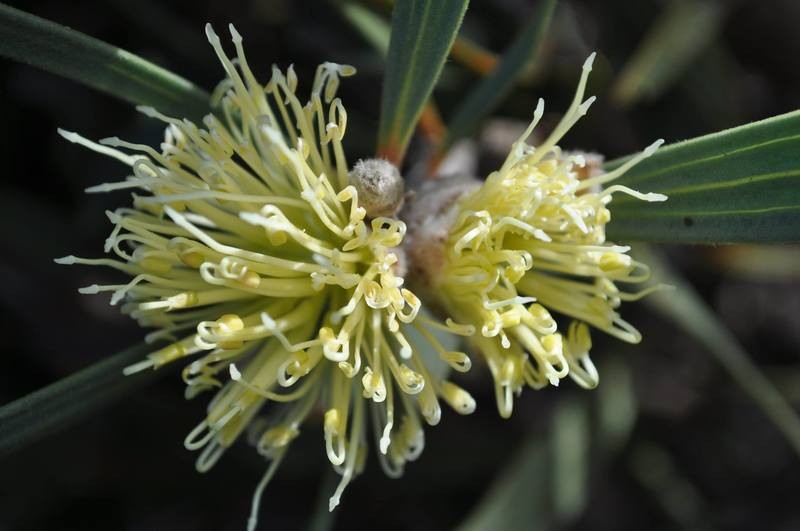Grey hakea
(Hakea cinerea)

Description
Hakea cinerea, commonly known as ashy or grey hakea, is a shrub in the family Proteaceae native to areas along the south coast in the Goldfields-Esperance region of Western Australia. It is a showy ornamental species bearing creamy-white flowers aging to orange with contrasting ash coloured grey-green leaves. Hakea cinerea is a rounded, rigid, non-lignotuberous shrub typically growing to a height of 0.7 to 2.5 metres (2.3 to 8.2 ft) with ascending branches. The inflorescence consists of 40-56 large showy creamy-white and yellow flowers turning orange with age in clusters in the leaf axils from August to November. The smooth pedicels are 4–6 mm (0.16–0.24 in) long. The style is 22–23 mm (0.87–0.91 in) long. Attractive stiff blue-grey leaves are rounded, 6–16 cm (2.4–6.3 in) long and 8–18 mm (0.31–0.71 in) wide tapering to a blunt point at the apex. Leaves are yellow at the base with 3 prominent grey-green longitudinal veins, 1-3 above and 3-6 on the underside. The small narrow fruit have a slightly rough surface and grow erect in groups of 1-5 in leaf axils are 2.2–2.5 cm (0.87–0.98 in) long and 0.6–0.9 mm (0.024–0.035 in) wide. Hakea cinerea was first formally described by Robert Brown in 1810 and published in Transactions of the Linnean Society of London. The specific epithet (cinerea) is derived from the Latin word cinereus meaning "of ashes", "ash coloured" or "ashen", referring to the colour of the foliage. Hakea cinerea is found from Ravensthorpe to Esperance and Israelite Bay. Has also been recorded at Point Culver at the western end of the Great Australian Bight. This species grows in a well-drained sunny site, preferring low-lying deep sand in heath, gravelly soils or low scrubland. An ornamental species good for windbreak or wildlife habitat. Hakea cinerea is presently classified "not threatened" by the Western Australian Government Department of Parks and Wildlife. Hakeas are similar to other plants in the Family Proteaceae, but have undivided leaves arranged alternately, sessile flowers arranged in loose groups in the axils of leaves or bracts, unlike those in the Banksia. Hakeas are similar to species of Grevillea but are distinguished from them in having persistent, woody fruits. (Those of grevilleas are not persistent and not woody. The upper and lower surfaces of the leaves of hakeas are similar (dissimilar in grevilleas), and the ovary and style are glabrous (but hairy in grevilleas).
Taxonomic tree:







